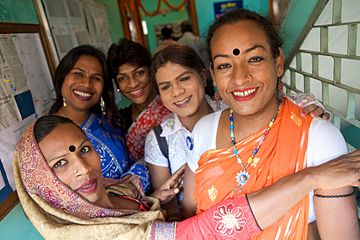Did you know?
You can double click on a word to look it up on TermGallery.
You can double click on a word to look it up on TermGallery.
Meanings of hijras in inglês
Usage of hijras in inglês
1
Transgender women, known as hijras, have long been considered auspicious in India.
2
But hijras like Seema believe more needs to be done.
3
Yet hijras have long been considered auspicious in India.
4
Other hijras generally offer anal sex too.
5
Under the Raj, the British tried to ban hijras as a breach of public decency but inevitably failed.
6
This means that now, for the first time, there are quotas of government jobs and college places for hijras.
7
Transgender women, known as hijras, have long been considered auspicious, and their blessings are sought at weddings and births.
8
Because a high number work in the sex industry, hijras are, according to Family Health International, particularly vulnerable to STDs.
9
They're an ancient community in South Asia where they're known as 'hijras but has anything changed since the landmark decision?
10
More recently, hijras have been seen as auspicious and are often asked to bless celebrations such as marriages and births.
11
Jeeva, one of India's transgender people, has benefited from landmark changes in the status of hijras over the past decade.
12
With their glittering saris, bright makeup and a reputation for bawdy song and dance, hijras, India's transgender minority, are hard to miss.
13
Singing and dancing bands of sari-clad hijras will often appear, invited or otherwise, at weddings and at the blessing ceremonies of newborn babies.
14
Not like this, she wanted to say, memories of the Black Orchid and the hijras' temple house thick as opium smoke in her mind.
15
We have sex because we have no other choice." Male-to-female transgenders, also known as "hijras", have a long history in South Asia, experts say.
16
India's trans-gender community, known as the Hijras, have played a role in its society for hundreds of years.
About this term
Frequent collocations
Hijras through the time


